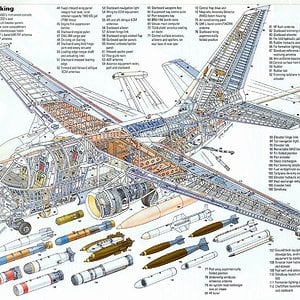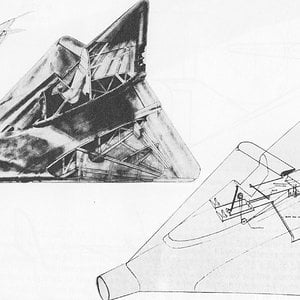Navigation
Install the app
How to install the app on iOS
Follow along with the video below to see how to install our site as a web app on your home screen.
Note: This feature may not be available in some browsers.
More options
You are using an out of date browser. It may not display this or other websites correctly.
You should upgrade or use an alternative browser.
You should upgrade or use an alternative browser.
Design and developmentAs conventional fuels were in extremely short supply by late 1944, Lippisch proposed that the P.13a be powered by coal. Initially, it was proposed that a wire-mesh basket holding coal be mounted behind a nose air intake, protruding slightly into the airflow and ignited by a gas burner. Following wind-tunnel testing of the ramjet and the coal basket, modifications were incorporated to provide more efficient combustion.
The coal was to take the form of small granules instead of irregular lumps, to produce a controlled and even burn, and the basket was altered to a mesh drum revolving on a vertical axis at 60 rpm. A jet of flame from tanks of bottled gas would fire into the basket once the P.13a had reached operating speed (above 320 km/h), whether by using a rocket to assist takeoff or by being towed.
The air passing through the ramjet would take the fumes from the burning coal towards the rear where they would mix under high pressure with clean air taken from a separate intake. The resulting mixture of gas would then be directed out through a rear nozzle to provide thrust. A burner and drum were built and tested successfully in Vienna by the design team before the end of the war.
It is not known what armament would have been carried by the P.13a; the MK 103 cannon would have been too heavy and large for such a small aircraft and it is possible that one or two large-calibre machineguns would have been used.
At the end of the war even the prototype DM-1 test glider had not been finished when it was captured by US forces. It was ordered to be completed by Lippisch's team and was then shipped to the USA where it was test-flown. Reportedly[by whom?] the results were very positive and lessons learned were incorporated into NASA's research aircraft of the 1950s and on.
Film footage exists which shows a gliding test of a scaled-down model of the P.13a. These tests began in May 1944 at Spitzerberg, near Vienna.[2]
After the war, Lippisch, working with American aircraft designer Convair, developed and tested the XF-92 based on his designs, leading to the eventual adoption of the F-102 Delta Dagger and its successor, the F-106 Delta Dart.
[edit] VariantsAkaflieg Darmstadt/Akaflieg München DM.1 - AKA Lippisch DM.1 A scale flying wind tunnel glider version of the proposed Lippisch P.13a
[edit] Specifications (P.13a, as designed)General characteristics
Crew: one
Length: 6.70 m (22 ft 0 in)
Wingspan: 6.00 m (19 ft 9 in)
Height: 3.25 m (10 ft 8 in)
Wing area: 20.0 m² (215 ft²)
Loaded weight: 2,295 kg (5,060 lb)
Powerplant: 1 × Kronach Lorin coal-burning ramjet
Performance
Maximum speed: 1,650 km/h (1,025 mph)
Range: 1,000 km (621 miles)
Wing loading: 115 kg/m² (24 lb/ft²)
The coal was to take the form of small granules instead of irregular lumps, to produce a controlled and even burn, and the basket was altered to a mesh drum revolving on a vertical axis at 60 rpm. A jet of flame from tanks of bottled gas would fire into the basket once the P.13a had reached operating speed (above 320 km/h), whether by using a rocket to assist takeoff or by being towed.
The air passing through the ramjet would take the fumes from the burning coal towards the rear where they would mix under high pressure with clean air taken from a separate intake. The resulting mixture of gas would then be directed out through a rear nozzle to provide thrust. A burner and drum were built and tested successfully in Vienna by the design team before the end of the war.
It is not known what armament would have been carried by the P.13a; the MK 103 cannon would have been too heavy and large for such a small aircraft and it is possible that one or two large-calibre machineguns would have been used.
At the end of the war even the prototype DM-1 test glider had not been finished when it was captured by US forces. It was ordered to be completed by Lippisch's team and was then shipped to the USA where it was test-flown. Reportedly[by whom?] the results were very positive and lessons learned were incorporated into NASA's research aircraft of the 1950s and on.
Film footage exists which shows a gliding test of a scaled-down model of the P.13a. These tests began in May 1944 at Spitzerberg, near Vienna.[2]
After the war, Lippisch, working with American aircraft designer Convair, developed and tested the XF-92 based on his designs, leading to the eventual adoption of the F-102 Delta Dagger and its successor, the F-106 Delta Dart.
[edit] VariantsAkaflieg Darmstadt/Akaflieg München DM.1 - AKA Lippisch DM.1 A scale flying wind tunnel glider version of the proposed Lippisch P.13a
[edit] Specifications (P.13a, as designed)General characteristics
Crew: one
Length: 6.70 m (22 ft 0 in)
Wingspan: 6.00 m (19 ft 9 in)
Height: 3.25 m (10 ft 8 in)
Wing area: 20.0 m² (215 ft²)
Loaded weight: 2,295 kg (5,060 lb)
Powerplant: 1 × Kronach Lorin coal-burning ramjet
Performance
Maximum speed: 1,650 km/h (1,025 mph)
Range: 1,000 km (621 miles)
Wing loading: 115 kg/m² (24 lb/ft²)








